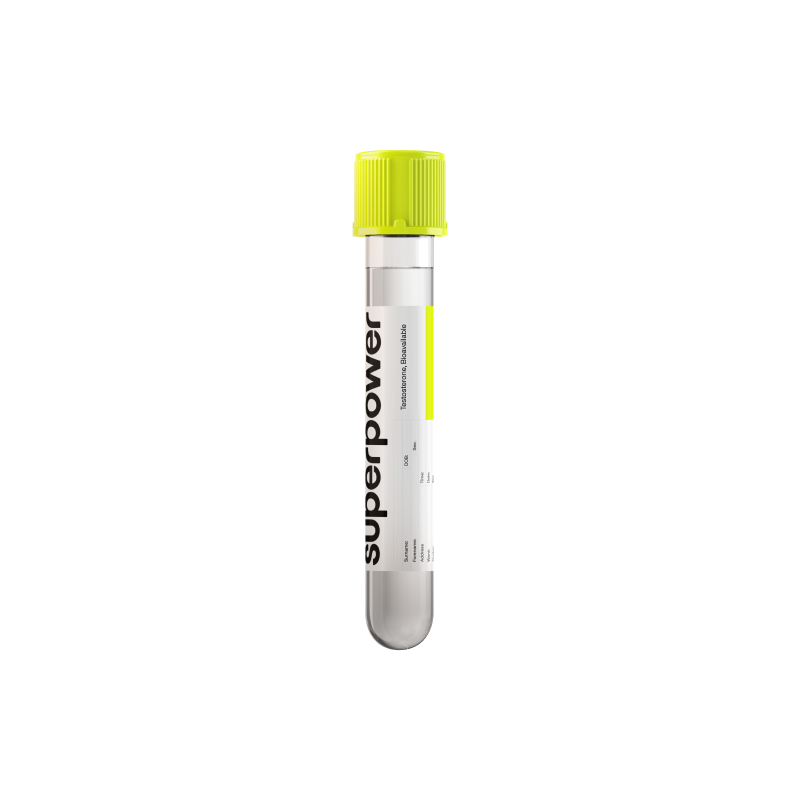Bioavailable testosterone includes the free and loosely bound fraction that tissues can actually use.
It often reflects real-world androgen exposure more accurately than total testosterone, especially when SHBG is high or low. Tracking this marker clarifies links to libido, energy, strength, recovery, mood, and body composition.
Key Benefits
See your active testosterone level driving energy, libido, and muscle health.
- Spot hormone imbalance when total testosterone looks normal but binding proteins are off.
- Clarify causes of low libido, fatigue, erectile issues, or reduced strength.
- Flag androgen excess in women with acne, hair growth, irregular periods, or PCOS.
- Guide testosterone therapy decisions and dosing by reflecting tissue-available hormone activity.
- Protect fertility by identifying low T and avoiding testosterone while trying to conceive.
- Track recovery with weight loss, thyroid treatment, or medication changes affecting binding proteins.
- Best interpreted with total testosterone, sex hormone–binding globulin (SHBG), albumin, LH/FSH, and your symptoms.
What is Testosterone, Bioavailable?
Bioavailable testosterone is the portion of testosterone in your bloodstream that can readily enter cells and act. Testosterone is a steroid hormone made mainly in the testes and, to a lesser extent, in the ovaries and adrenal glands, from cholesterol. In blood, most testosterone is bound to proteins. A large share is held tightly by sex hormone–binding globulin (SHBG) and is not readily available. A smaller share is either unbound (“free”) or weakly attached to albumin; together these make up bioavailable testosterone because they can detach and reach tissues.
This is the fraction that actually delivers the androgen signal. It diffuses into tissues, dissociates if needed, binds the androgen receptor (AR), and switches on genes that support sexual function and libido, preserve muscle and bone, drive red blood cell production (erythropoiesis), and influence body hair, skin, mood, and energy. In women, it also supports sexual desire, ovarian function, and bone health. Because it represents the hormone that tissues can use, bioavailable testosterone offers a practical view of the body’s active testosterone supply, not just what is circulating.
Why is Testosterone, Bioavailable important?
Bioavailable testosterone is the fraction of testosterone that can actually reach and activate tissues—free hormone plus the portion loosely bound to albumin, not the tightly bound pool on SHBG. Because it reflects what cells “see,” it maps directly to energy, muscle and bone maintenance, sexual function, mood, red blood cell production, and metabolic regulation. Reference intervals are sex- and age-specific (higher in adult men, much lower in women, dynamic in youth). For most adults, feeling well tends to align with values in the middle of the appropriate reference range; many men feel best in the mid-to-upper segment.
When this value runs low, it usually indicates insufficient androgen signal at the tissue level or excess SHBG tying hormone up. In men, that can show up as low libido, fatigue, depressed mood, reduced muscle and strength, more body fat, anemia, and lower bone density. Women may notice lowered sexual desire, diminished vitality, and reduced lean mass. In adolescents, low levels can delay or blunt pubertal development. Pregnancy and high estrogen states raise SHBG, often lowering bioavailable testosterone without true deficiency.
When bioavailable testosterone is high, tissues are receiving an amplified androgen signal. In men, this can manifest as acne, oily skin, irritability, higher hematocrit, and hair loss; low SHBG from obesity or insulin resistance can push bioavailable levels up even if total looks “normal.” In women, elevated values suggest hyperandrogenism (such as PCOS), with hirsutism, acne, scalp hair thinning, and irregular periods; in teens, it can trigger early or rapid pubertal changes.
Big picture, this marker integrates gonadal output with liver-derived SHBG, thyroid status, insulin sensitivity, and estrogen balance. Persistently low values link to sarcopenia, osteoporosis, and anemia in men, while high values in women correlate with metabolic risk in PCOS. Interpreting it alongside SHBG, total testosterone, estradiol, and metabolic markers clarifies whole-system health and long-term risk.
What Insights Will I Get?
Testosterone, Bioavailable estimates the fraction of testosterone that is free or loosely albumin-bound and can readily enter cells. It reflects the actual androgen signal reaching tissues that influence energy production, muscle and bone maintenance, red blood cell formation, glucose–lipid metabolism, vascular tone, mood, cognition, libido, and fertility.
Low values usually reflect too little production or too much binding by sex hormone–binding globulin (SHBG), reducing tissue access. In men, this aligns with androgen deficiency (hypogonadism) from testicular or pituitary causes, chronic illness, or certain drugs, and can manifest as low libido, weaker erections, reduced morning erections, fatigue, depressed mood, loss of muscle, increased fat, low bone density, and anemia. In women, low bioavailable testosterone can present as reduced sexual desire and arousal, lower vitality and muscle strength, and bone loss; levels decline with age and drop further with oral estrogen, which raises SHBG. Pregnancy raises SHBG, so bioavailable may be lower relative to total.
Being in range suggests sufficient androgen signaling for stable metabolic, reproductive, musculoskeletal, hematologic, and cognitive function. In adult men, symptom-free status often corresponds to mid–to–upper portions of the reference interval; in women, mid–range for age and life stage generally indicates balanced ovarian–adrenal androgen input.
High values usually reflect excess production or low SHBG. In men, exogenous androgens, testicular/adrenal tumors, or insulin resistance (low SHBG) can elevate bioavailable levels, with risks of acne, oily skin, scalp hair thinning, erythrocytosis, and adverse lipids. In women, polycystic ovary syndrome and adrenal causes commonly raise bioavailable testosterone, leading to irregular menses, hirsutism, acne, and hair thinning.
Notes: Values vary by age, sex, time of day (higher in the morning), illness, and medications. SHBG strongly influences results. Assay methods differ; some labs calculate bioavailable testosterone from total testosterone, SHBG, and albumin, which can affect comparability across labs.



.svg)



.png)
.png)
.png)
.png)








